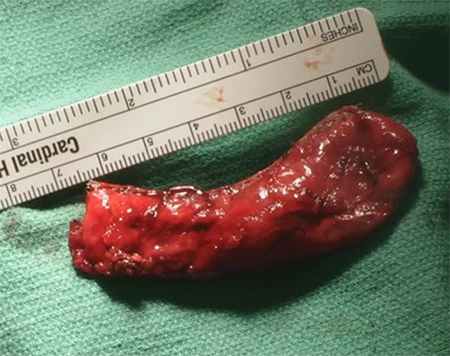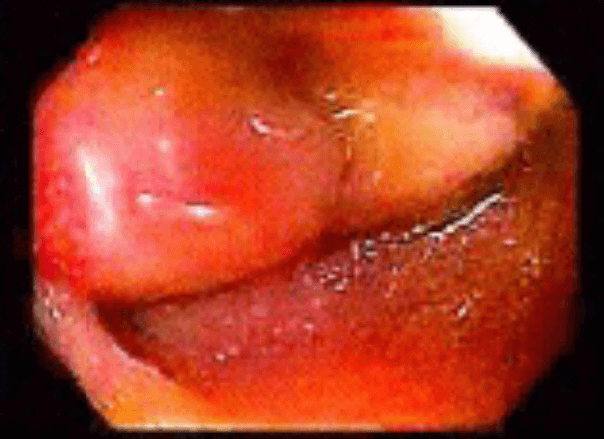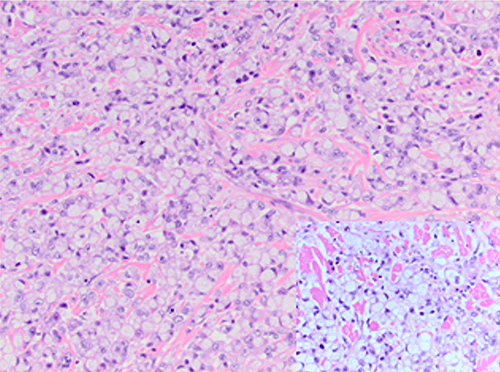Abstract
Background
Esophageal diverticula are common problems associated with abnormal motility or extrinsic anatomic forces; presented within this case is an example of an aberrant right subclavian artery, one of the most common aortic arch anomalies that cause extrinsic pressure on the esophagus leading to the formation of a traction diverticulum.
Summary
A 59-year-old African American female presented to the emergency department with a history of dysphagia with intolerance to both solids and liquids. A CT Scan revealed a large upper esophageal diverticulum and a normal variant aberrant right subclavian artery coursing posterior to the esophagus near the neck of the diverticulum. After a course of nutritional support, the patient underwent ligation of the aberrant subclavian vessel and excision of the esophageal diverticula. She had an uncomplicated postoperative course with eventual resumption of oral intake and return to normal function.
Conclusion
The surgical team hypothesizes that the patient’s congenital aberrant subclavian artery led to the formation of a traction diverticulum in the esophagus and was the ultimate cause of her symptomatic profile. The incidence of this etiology of esophageal diverticula is unknown and this is the first published case report of such a phenomenon. Treatment of such a cause of esophageal diverticula uses the same principles required for all esophageal diverticular—removing the underlying etiology and, if necessary due to symptoms, resecting the diverticulum.
Key Words
Esophageal diverticulum, aberrant subclavian artery, Kommerell diverticulum, Dysphagia Lusoria
Case Description
Esophageal diverticula refer to abnormal outpouchings of the esophageal wall and are classified either by location, etiology (congenital, pulsion, or traction), or histology (true, false).1 Congenital esophageal diverticula are false diverticula, present at birth, and located in the posterior esophagus.2 Pulsion, or false, diverticula form as a result of high intraluminal pressure against a weakness in the esophageal wall (i.e., Zenker Diverticulum). These contain mucosa and submucosa, along with few muscle fibers. Traction, or true, diverticula are a consequence of pulling forces external to the esophagus, usually from an inflammatory process (often inflamed mediastinal lymph nodes caused by Tuberculosis or Histoplasmosis).1,3,4 This leads to a tissue reaction that causes a full thickness outpouching of all three layers of the esophageal wall, muscle included, that results in a wide-mouthed diverticulum. Treatment of esophageal diverticula requires correcting the underlying etiology of the diverticulum with or without removal of the diverticulum itself.
The presence of an aberrant right subclavian artery is a known normal variant of the aortic arch anatomy, with a reported incidence of 0.2-4.4 percent.5 The aberrant vessel arises distal to the left subclavian and courses posterior to the esophagus in 80 percent of patients (15 percent between the esophagus and trachea and 5 percent anterior to the trachea). Aneurysmal dilatation of the takeoff of the vessel at the aorta is known as a Kommerell Diverticulum.6 Dysphagia lusoria is a common presentation of aberrant right subclavian artery and is described as difficulty swallowing because of extrinsic compression on the posterior esophagus by the aberrant vessel.
This case report proposes a novel etiology for the development of traction esophageal diverticula. The patient presented has an aberrant right subclavian vessel that coincides with a large esophageal diverticulum. At time of surgery, it was noted that the vessel was not only coursing directly posterior to the neck of the diverticulum, but was also tightly-adhesed to the muscular wall of the esophagus. It is our hypothesis that the aberrant vessel caused significant traction on the esophageal wall leading to the development of the large esophageal diverticulum. With review of the current literature, the incidence of this etiology of esophageal diverticulum is unknown and this is the first published case report of such a phenomenon.
A 59-year-old African-American female presented to the emergency department reporting a history of dysphagia to solids progressing to liquids. She had recently been unable to take liquids without coughing and had significant weight loss. Her past medical history included severe rheumatoid arthritis and COPD. Physical examination at the time of presentation revealed that the patient had a hoarse voice and signs of malnutrition (BMI=16.6) but was otherwise unremarkable. Her prealbumin was determined to be <5 at this time. The patient had worked as a factory worker in the past but was now retired, and she had a four-pack-per-year history of smoking. A CT scan of the chest with contrast revealed findings of a normal variant aberrant right subclavian artery with a Kommerell diverticulum proximally that coursed posterior to the proximal esophagus, and a 5.0 x 2.5 cm proximal esophageal diverticulum at the level of the left thoracic inlet (Figure 1). At the time of presentation, the patient was unable to complete a barium esophagram or esophageal manometry due to aspiration, and it was determined that data from these studies would not influence clinical decision-making.












